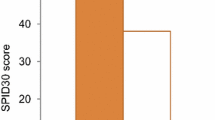Abstract
-
▴ The fentanyl buccal tablet (FBT) is a new formulation of fentanyl that uses an effervescent drug delivery system to enhance penetration across the buccal mucosa for the treatment of breakthrough pain in opioid-tolerant patients with cancer.
-
▴ Fentanyl is rapidly absorbed from FBT across the buccal mucosa and into the bloodstream.
-
▴ Fentanyl is more rapidly absorbed and bioavailability is higher from FBT than from the oral transmucosal fentanyl citrate formulation.
-
▴ In a well designed phase III trial in opioid-tolerant patients with cancer, a single dose of FBT 100–800μg provided clinically significant improvements in pain intensity from 15 to 60 minutes after the dose.
-
▴ Single FBT doses of 100–800μg were generally well tolerated; the majority of adverse events were mild to moderate in nature and typical of those associated with opioids.


Similar content being viewed by others
Notes
The use of trade names is for product identification purposes only and does not imply endorsement.
References
Portenoy RK, Payne D, Jacobsen P. Breakthrough pain: characteristics and impact in patients with cancer pain. Pain 1999 May; 81: 129–34
Fine PG. Breakthrough cancer pain: epidemiology, characteristics and management. CNS Drugs 2000 May; 13: 313–9
Mercadante S, Arcuri E. Breakthrough pain in cancer patients: pathophysiology and treatment. Cancer Treat Rev 1998 Dec; 24: 425–32
Darwish M, Tempero K, Kirby M, et al. Pharmacokinetics and dose proportionality of fentanyl effervescent buccal tablets in healthy volunteers. Clin Pharmacokinet 2005; 44 (12): 1279–86
Muijsers RBR, Wagstaff AJ. Transdermal fentanyl: an updated review of its pharmacological properties and therapeutic efficacy in chronic cancer pain control. Drugs 2001; 61 (15): 2289–307
Cephalon Inc. Prescribing information for Fentora™ (fentanyl buccal tablet). Available from URL: http://www.fda.gov/cder/foi/label/2006/021947lbl.pdf [Accessed 2006 Sep 23]
Horváth G, Benedek G, Szikszay M. Enhancement of fentanyl analgesia by clonidine plus verapamil in rats. Anesth Analg 1990; 70: 284–8
Horváth G, Szikszay M, Rubicsek G, et al. An isobolographic analysis of the hypnotic effects of combinations of dexmedetomidine with fentanyl or diazepam in rats. Life Sci 1992; 50: PL215–20
Hu C, Fleckneil PA, Liles JH. Fentanyl and medetomidine anaethesia in the rat and its reversal using atipamazole and either nalbuphine or butorphanol. Lab Animals 1992; 26: 15–22
Yaster M, Keohler RC, Traystman RJ. Interaction of fentanyl and pentobarbital on peripheral and cerebral hemodynamics in newborn lambs. Anesthsiology 1989; 70: 461–9
Reves JG, Kissin I, Fournier SE, et al. Additive negative ionotropic effect of a combination of diazepam and fentanyl. Anesth Anal 1984; 63: 97–100
Brown JH, Pleuvry BJ. Antagonism of the respiratory effects of alfentanil and fentanyl by naloxone in the conscious rabbit. Br J Anaesth 1981; 53: 1033–7
Darwish M, Tempero K, Kirby M, et al. Relative bioavailability of the fentanyl effervescent buccal tablet (FEBT) 1080 micrograms versus oral transmucosal fentanyl citrate 1600 micrograms and dose proportionality of FEBT 270 to 1300 micrograms: a single-dose, randomized, open-label, three-period study in healthy adult volunteers. Clin Ther 2006 May; 28 (5): 715–24
Darwish M, Kirby M, Robertson P, et al. Absolute and relative bioavailability of fentanyl buccal tablet and oral transmucosal fentanyl citrate. J Clin Pharmacol. In press
Darwish M, Kirby M, Robertson Jr P, et al. Comparison of equivalent doses of fentanyl buccal tablets and arteriovenous differences in fentanyl pharmacokinetics. Clin Pharmacokinet 2006; 45 (8): 843–50
Darwish M, Kirby M, Robertson Jr P, et al. Pharmacokinetic properties of fentanyl effervescent buccal tablets: a phase I, open-label, crossover study of single-dose 100, 200, 400, and 800 micrograms in healthy adult volunteers. Clin Ther 2006 May; 28 (5): 707–14
Darwish M, Kirby M, Jiang JG. Effect of dwell time on the pharmacokinetics of fentanyl effervescent buccal tablets [abstract no. P-37E plus poster]. American Society of Health-System Pharmacists’ Summer Meeting; 2006 June 25–28; Orlando (FL)
Eichman JD, Robinson JR. Mechanistic studies on effervescent-induced permeability enhancement. Pharm Res 1998; 15 (6): 925–30
Durfee S, Messina J, Khankari R. Fentanyl effervescent buccal tablets: enhanced buccal absorption. Am J Drug Deliv 2006; 4 (1): 1–5
Portenoy RK, Taylor D, Messina J, et al. A randomized, placebo-controlled study of fentanyl buccal tablet for breakthrough pain in opioid-treated patients with cancer. Clin J Pain 2006 Nov/Dec; 22 (9): 805–11
Webster L, Taylor D, Peppin J, et al. Open-label study of fentanyl effervescent buccal tablets in patients with noncancer pain and breakthrough pain: patient preference assessment [abstract no. 804 plus poster]. J Pain 2006 Apr; 74 Suppl. 2. Plus poster presented at the American Pain Society’s annual meeting; 2006 May 3–6; San Antonio, (TX): S52
Hale M, Webster L, Peppin J, et al. Open-label study of fentanyl effervescent buccal tablets in patients with chronic pain and breakthrough pain: interim safety and tolerability results [abstract no. 3040 plus poster]. American Academy of Pain Medicine’s Annual Meeting; 2006 Feb 22–25; San Diego (CA)
Nalamachu S, Messina J, Xie F. Evaluation of patients’ preference for fentanyl effervescent buccal tablets to manage breakthrough pain [bstract no. 06-A-1883-AAPMR]. American Academy of Physical Medicine and Rehabilitation; 2006 Nov 9–12; Honolulu (HI)
Nalamachu S, Messina J, Xie F. Impact of fentanyl effervescent buccal tablets on mood, functioning, and quality-of-life in patients with breakthrough pain [abstract no. 06-A-1874-AAPMR]. American Academy of Physical Medicine and Rehabilitation; 2006 Nov 9–12; Honolulu (HI)
Portenoy RK, Xie F, Messina J, et al. Fentanyl buccal tablet (FBT) for the treatment of breakthrough pain in opioid-treated patients with chronic low back pain: a randomized, placebo-controlled study [abstract plus poster]. American Society of Regional Anesthesia and Pain Medicine; 2006 Nov 16–19; San Francisco (CA)
Slatkin N, Cham V, Niebler G, et al. Long-term tolerability of fentanyl effervescent buccal tablets: interim analysis in patients with cancer-related breakthrough pain. [abstract no. 8567 plus poster] American Society of Clinical Oncology’s 42nd Annual Meeting; 2006 June 2–6; Atlanta (GA): 484
Author information
Authors and Affiliations
Corresponding author
Rights and permissions
About this article
Cite this article
Blick, S.K.A., Wagstaff, A.J. Fentanyl Buccal Tablet. Drugs 66, 2387–2393 (2006). https://doi.org/10.2165/00003495-200666180-00013
Published:
Issue Date:
DOI: https://doi.org/10.2165/00003495-200666180-00013




